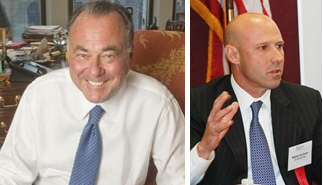Trending
 Lawmakers reach sweeping housing deal with “good cause eviction,” new 421a
Lawmakers reach sweeping housing deal with “good cause eviction,” new 421a “Investing before the ‘all clear’ sign”: Jon Gray on Blackstone’s $10B apartment deal
“Investing before the ‘all clear’ sign”: Jon Gray on Blackstone’s $10B apartment deal Macerich faces “imminent” default on $300M Santa Monica Place loan
Macerich faces “imminent” default on $300M Santa Monica Place loan Tony Park and Elad Dror take a gamble on Koreatown office-to-resi conversion
Tony Park and Elad Dror take a gamble on Koreatown office-to-resi conversionCBRE bullish on Downtown after Cushman’s dire prediction
A day after a Cushman & Wakefield broker said at a quarterly market briefing that the vacancy rate Downtown could rise by two-thirds, a top broker at competitor CB Richard Ellis gave a more optimistic view of the area during its own briefing today.
Stephen Siegel, chairman of global brokerage at commercial services firm CBRE, said many of the financial giants may not give back all the space once expected. He, along with executive managing director Matthew Van Buren, spoke this morning at the CBRE fourth-quarter market briefing at the firm’s Midtown office.
“I also believe with the exception of 85 Broad [Street], Goldman Sachs will probably retain a lot more space than they were anticipated to, maybe 1 New York Plaza, etc.,” he said. “I think Merrill [Lynch] will stay. If not with all their space then with a significant amount of their space. That is my opinion.”
Although he would not identify Goldman Sachs by name, he suggested in another instance that the firm had removed from the market 260,000 square feet previously offered for sublet at 1 Liberty Plaza, and once again utilized that space.
His comments were in contrast to a prediction yesterday by Cushman executive director Andrew Peretz, that the vacancy rate Downtown could rise from December’s level of 9.6 percent to 15.75 percent as firms return space to the market.
The Downtown market is an active focus of speculation because rents have not fallen as dramatically as in Midtown, and the vacancy rate Downtown at 9.6 percent, is the lowest in the city. However, many brokers expect financial institutions to dump millions of square feet on the market, raising vacancy rates.
For Manhattan overall, the December vacancy rate, as measured by CBRE in the firm’s office leasing report released today, shows an increase of .3 points from the prior month to 9.8 percent. For the same period, the firm reported that average asking rents fell by $0.16 per foot to $49.01 per square foot, but new leasing activity rose by 23 percent to 2.2 million square feet.
Siegel was also optimistic that the leasing market in Manhattan had reached bottom, with asking rent reductions flattening and absorption turning positive in recent months.
Although he could not immediately provide a figure for the net decrease in available space if leased by specific tenants currently in the market, he indicated it could be significant.
“I can tell you I know for sure there is about 600,000 to 700,000 square feet that is in the market right now that will create 100 percent absorption,” he said.

